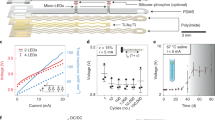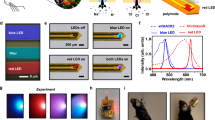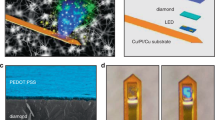Abstract
The use of optogenetics to regulate neuronal activity has revolutionized the study of the neural circuitry underlying a number of complex behaviors in rodents. Advances have been particularly evident in the study of brain circuitry and related behaviors, while advances in the study of spinal circuitry have been less striking because of technical hurdles. We have developed and characterized a wireless and fully implantable optoelectronic device that enables optical manipulation of spinal cord circuitry in mice via a microscale light-emitting diode (µLED) placed in the epidural space (NeuroLux spinal optogenetic device). This protocol describes how to surgically implant the device into the epidural space and then analyze light-induced behavior upon µLED activation. We detail optimized optical parameters for in vivo stimulation and demonstrate typical behavioral effects of optogenetic activation of nociceptive spinal afferents using this device. This fully wireless spinal µLED system provides considerable versatility for behavioral assays compared with optogenetic approaches that require tethering of animals, and superior temporal and spatial resolution when compared with other methods used for circuit manipulation such as chemogenetics. The detailed surgical approach and improved functionality of these spinal optoelectronic devices substantially expand the utility of this approach for the study of spinal circuitry and behaviors related to mechanical and thermal sensation, pruriception and nociception. The surgical implantation procedure takes ~1 h. The time required for the study of behaviors that are modulated by the light-activated circuit is variable and will depend upon the nature of the study.
This is a preview of subscription content, access via your institution
Access options
Access Nature and 54 other Nature Portfolio journals
Get Nature+, our best-value online-access subscription
$29.99 / 30 days
cancel any time
Subscribe to this journal
Receive 12 print issues and online access
$259.00 per year
only $21.58 per issue
Buy this article
- Purchase on Springer Link
- Instant access to full article PDF
Prices may be subject to local taxes which are calculated during checkout







Similar content being viewed by others
Data availability
Source data are provided with this paper. Additional requests should be addressed to the corresponding authors.
References
Boyden, E. S. A history of optogenetics: the development of tools for controlling brain circuits with light. F1000 Biol. Rep. 3, 11 (2011).
Carr, F. B. & Zachariou, V. Nociception and pain: lessons from optogenetics. Front. Behav. Neurosci. 8, 69 (2014).
Samineni, V. K. et al. Fully implantable, battery-free wireless optoelectronic devices for spinal optogenetics. Pain 158, 2108–2116 (2017).
Park, S. I. S. Il et al. Soft, stretchable, fully implantable miniaturized optoelectronic systems for wireless optogenetics. Nat. Biotechnol. 33, 1280–1286 (2015).
Zhang, Y. Y. et al. Battery-free, fully implantable optofluidic cuff system for wireless optogenetic and pharmacological neuromodulation of peripheral nerves. Sci. Adv. 5, 1–12 (2019).
Vázquez-Guardado, A., Yang, Y., Bandodkar, A. J. & Rogers, J. A. Recent advances in neurotechnologies with broad potential for neuroscience research. Nat. Neurosci. 23, 1522–1536 (2020).
Bridges, A. W. & García, A. J. Anti-inflammatory polymeric coatings for implantable biomaterials and devices. J. Diabetes Sci. Technol. 2, 984–994 (2008).
Bedi, S. S. et al. Chronic spontaneous activity generated in the somata of primary nociceptors is associated with pain-related behavior after spinal cord injury. J. Neurosci. 30, 14870–14882 (2010).
Djouhri, L., Koutsikou, S., Fang, X., McMullan, S. & Lawson, S. N. Spontaneous pain, both neuropathic and inflammatory, is related to frequency of spontaneous firing in intact C-fiber nociceptors. J. Neurosci. 26, 1281–1292 (2006).
DeBerry, J. J. et al. Differential regulation of bladder pain and voiding function by sensory afferent populations revealed by selective optogenetic activation. Front. Integr. Neurosci. 12, 1–13 (2018).
Montgomery, K. L. et al. Wirelessly powered, fully internal optogenetics for brain, spinal and peripheral circuits in mice. Nat. Methods 12, 969–974 (2015).
Iyer, S. M. et al. Virally mediated optogenetic excitation and inhibition of pain in freely moving nontransgenic mice. Nat. Biotechnol. 32, 274–278 (2014).
Harding, E. K., Fung, S. W. & Bonin, R. P. Insights into spinal dorsal horn circuit function and dysfunction using optical approaches. Front. Neural Circuits 14, 1–21 (2020).
Copits, B. A., Pullen, M. Y. & Gereau, R. W. Spotlight on pain: optogenetic approaches for interrogating somatosensory circuits. Pain 157, 2424–2433 (2016).
Francois, A. et al. A brainstem-spinal cord inhibitory circuit for mechanical pain modulation by GABA and enkephalins. Neuron 93, 822–839 (2017).
Christensen, A. J. et al. In vivo interrogation of spinal mechanosensory circuits. Cell Rep 17, 1699–1710 (2016).
Lu, C. et al. Flexible and stretchable nanowire-coated fibers for optoelectronic probing of spinal cord circuits. Sci. Adv. https://doi.org/10.1126/sciadv.1600955 (2017).
Lu, L. et al. Wireless optoelectronic photometers for monitoring neuronal dynamics in the deep brain. Proc. Natl Acad. Sci. USA 115, E1374–E1383 (2018).
Wang, Y. et al. Flexible and fully implantable upconversion device for wireless optogenetic stimulation of the spinal cord in behaving animals. Nanoscale 12, 2406–2414 (2020).
Butler, R. K. & Finn, D. P. Stress-induced analgesia. Prog. Neurobiol. 88, 184–202 (2009).
Mickle, A. D. & Gereau, R. W. 4th A bright future? Optogenetics in the periphery for pain research and therapy. Pain 159, 65–73 (2018).
Madisen, L. et al. A toolbox of Cre-dependent optogenetic transgenic mice for light-induced activation and silencing. Nat. Neurosci. 15, 793–802 (2012).
Bonin, R. P. et al. Epidural optogenetics for controlled analgesia. Mol. Pain 12, 1–11 (2016).
Mishra, S. K., Tisel, S. M., Orestes, P., Bhangoo, S. K. & Hoon, M. A. TRPV1-lineage neurons are required for thermal sensation. EMBO J 30, 582–593 (2011).
Cavanaugh, D. J. et al. Restriction of transient receptor potential vanilloid-1 to the peptidergic subset of primary afferent neurons follows its developmental downregulation in nonpeptidergic neurons. J. Neurosci. 31, 10119–10127 (2011).
Chaplan, S. R., Bach, F. W., Pogrel, J. W., Chung, J. M. & Yaksh, T. L. Quantitative assessment of tactile allodynia in the rat paw. J. Neurosci. Methods 53, 55–63 (1994).
Brenner, D. S., Golden, J. P. & Gereau, R. W. IV A novel behavioral assay for measuring cold sensation in mice. PLoS ONE https://doi.org/10.1371/journal.pone.0039765 (2012).
Beaudry, H., Daou, I., Ase, A. R., Ribeiro-Da-Silva, A. & Séguela, P. Distinct behavioral responses evoked by selective optogenetic stimulation of the major TRPV1+ and MrgD+ subsets of C-fibers. Pain 158, 2329–2339 (2017).
Rogers, J. A. et al. Injectable and injectable cellular-scale electronic devices. US patent 5861366 (2020).
Acknowledgements
We thank J. Sinn-Hanlon for generating the illustrations in Fig. 2. This work was supported by NIH grants NS042595 to R.G., NS103472-02 to J.G.R., DA049569 to B.C. and NEUROLUX SBIR GRANT 5R44MH114944-02.
Author information
Authors and Affiliations
Contributions
J.P.G. and R.W.G. developed the surgical approach. B.A.C. performed electrophysiology experiments. J.G.G. performed sensory behavior experiments. J.G.G. and J.P.G. performed optogenetic experiments. S.K.V. maintained and genotyped mice used in these studies. R.A. and Y.H. provided support with computer modeling for µLED device functioning. J.A.R, A.R.B., F.L. and Y.Y. designed and implemented all of the updates to the spinal µLED device in addition to providing technical support. All authors contributed to writing and editing the manuscript.
Corresponding authors
Ethics declarations
Competing interests
A.R.B., R.W.G. and J.A.R. are cofounders of NeuroLux. F.L. and Y.Y. work for NeuroLux, a company that manufactures wireless optoelectronic devices. The device described here is included in the current NeuroLux portfolio29.
Additional information
Peer review information Nature Protocols thanks Maysam Ghovanloo, Ryan Koppes and the other, anonymous reviewer(s) for their contribution to the peer review of this work.
Publisher’s note Springer Nature remains neutral with regard to jurisdictional claims in published maps and institutional affiliations.
Related links
Key references using this protocol
Samineni, V. K. et al. Pain 158, 2108–2116 (2017): https://doi.org/10.1097/j.pain.0000000000000968
Park, S. I. et al. Nat. Biotechnol. 33, 1280–1286 (2015): https://doi.org/10.1038/nbt.3415
Vázquez-Guardado, A. et al. Nat. Neurosci. 23, 1522–1536 (2020): https://doi.org/10.1038/s41593-020-00739-8
Zhang, Y. et al Sci. Adv. 5, eaaw5296 (2019): https://doi.org/10.1126/sciadv.aaw5296
Supplementary information
Supplementary Information
Supplementary Methods and Supplementary Figs. 1–6.
Supplementary Video 1
Step-by-step demonstration of the surgical implantation procedure for the spinal µLED device.
Source data
Source Data Fig. 3
Statistical source data for physiology and animal behavior.
Source Data Fig. 5
Statistical source data for physiology and animal behavior.
Source Data Fig. 6
Statistical source data for physiology and animal behavior.
Source Data Fig. 7
Statistical source data for physiology and animal behavior.
Rights and permissions
About this article
Cite this article
Grajales-Reyes, J.G., Copits, B.A., Lie, F. et al. Surgical implantation of wireless, battery-free optoelectronic epidural implants for optogenetic manipulation of spinal cord circuits in mice. Nat Protoc 16, 3072–3088 (2021). https://doi.org/10.1038/s41596-021-00532-2
Received:
Accepted:
Published:
Issue Date:
DOI: https://doi.org/10.1038/s41596-021-00532-2
This article is cited by
-
Body-conformable light-emitting materials and devices
Nature Photonics (2024)
-
Design of protective and high sensitivity encapsulation layers in wearable devices
Science China Technological Sciences (2023)
-
Chest-scale self-compensated epidermal electronics for standard 6-precordial-lead ECG
npj Flexible Electronics (2022)
Comments
By submitting a comment you agree to abide by our Terms and Community Guidelines. If you find something abusive or that does not comply with our terms or guidelines please flag it as inappropriate.



